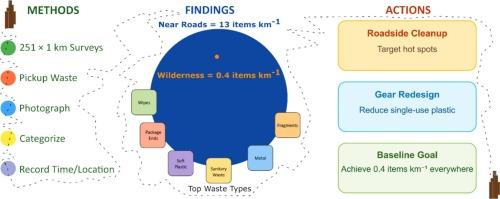迷失在太平洋屋脊小径上:4270公里的荒野废物分布和特征调查
IF 7.1
2区 环境科学与生态学
Q1 ENGINEERING, ENVIRONMENTAL
引用次数: 0
摘要
管理不善的废物威胁着环境和人类健康。为了更好地了解休闲步道的废物来源和影响,我们调查了整个4270公里的太平洋山脊步道,进行了251次废物调查(每16公里调查1公里)。调查人员对步道2米范围内的垃圾进行了统计和分类。根据每公里12.5件的平均数量,我们估计2023年沿着这条小路有53,000件(12,000-130,000件)垃圾。废物数量与到最近道路的距离呈负对数线性关系。在偏远地区(调查起点距离公路10公里),垃圾很少(每公里0.4块),但靠近公路(距离公路10米),垃圾增加到每公里13块。最常见的材料类型是软塑料(36%)、金属(11%)和卫生垃圾(10%)。最常见的形态是碎片(47%)、包装末端(7%)和湿巾(6%)。垃圾上能看到的品牌很少(48件)。我们评估了这种调查方法的偏差,表明与进行两次调查或使用两倍的调查人员相比,它低估了50%的浪费数量。在积雪覆盖或夜间测量的步道路段也减少了观测到的数量。这些发现表明,道路附近的清理、废物处理教育、减少塑料使用以及户外消费品生产商的创新可以减少小路上的垃圾。我们建议将每公里0.4件的基线值作为所有空间的废物管理目标。本文章由计算机程序翻译,如有差异,请以英文原文为准。

Lost on the Pacific Crest Trail: a 4,270 km survey of wilderness waste distribution and characteristics
Mismanaged waste threatens the environment and human health. To better understand waste sources and impacts along recreation trails, we surveyed the entire 4,270 km Pacific Crest Trail, conducting 251 waste surveys (1 km every 16 km). Surveys counted and classified waste within 2 m of the trail. We estimated that there were 53,000 pieces (12,000–130,000) of waste along the trail in 2023, based on a mean count of 12.5 pieces per km. Waste count had a negative log–log linear relationship with distance to the nearest road. Far in the backcountry (survey start 10 km from a road), waste was sparse (0.4 pieces per km), but close to roads (10 m from a road), waste increased to 13 pieces per km. The most common material types were soft plastic (36 %), metal (11 %), and sanitary waste (10 %). The most common morphologies were fragments (47 %), package ends (7 %), and wipes (6 %). Brands visible on waste were rare (48 pieces). We assessed the bias of this survey method, showing that it underestimated waste counts by 50 % compared to conducting the survey twice or with twice the number of surveyors. Surveying trail sections with snow cover or at night also reduced observed counts. These findings suggest that cleanup near roads, waste handling education, reduced plastic use, and innovation from outdoor consumer product producers could reduce trail waste. We propose that a baseline value of 0.4 pieces per km should be a waste management target to achieve for all spaces.
求助全文
通过发布文献求助,成功后即可免费获取论文全文。
去求助
来源期刊

Waste management
环境科学-工程:环境
CiteScore
15.60
自引率
6.20%
发文量
492
审稿时长
39 days
期刊介绍:
Waste Management is devoted to the presentation and discussion of information on solid wastes,it covers the entire lifecycle of solid. wastes.
Scope:
Addresses solid wastes in both industrialized and economically developing countries
Covers various types of solid wastes, including:
Municipal (e.g., residential, institutional, commercial, light industrial)
Agricultural
Special (e.g., C and D, healthcare, household hazardous wastes, sewage sludge)
 求助内容:
求助内容: 应助结果提醒方式:
应助结果提醒方式:


